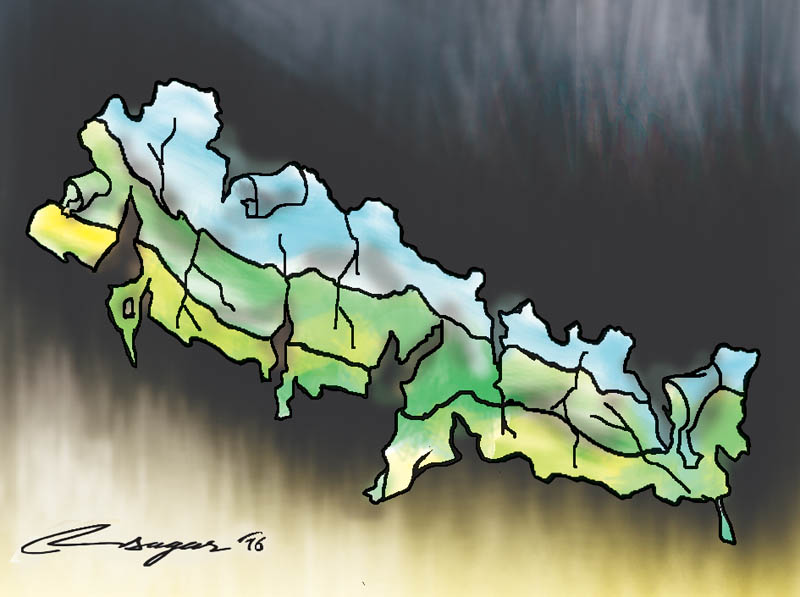Two disasters and Nepal: The economic slide
However, in every crisis there is opportunity. There are a few areas the government can focus on such as trade diversification with focus on domestic production to reduce our over-dependence on India
Nepal’s economy was looking forward to a recovery following the devastating earthquake of April the 25th. With strong response from the international donor community at the international donors’ conference following the Post Disaster Needs Assessment (PDNA), expectations of reconstruction buoyed the prospect of a strong economic recovery. But even before the buoyancy began, Nepal fell prey to another prolonged political limbo: the unrest in Terai.
The “unofficial economic blockade” imposed on Nepal dented any remaining hope for an economic recovery. Although this was not the first blockade in Nepal, its effect was severe due to the increased foreign dependency for essential goods (especially on India, on whom Nepal relied for 93.9% of exports and 79.4 % of imports).
The effect of this blockade has been more severe than the blockade imposed at the end of the Panchayat era and the ten-year civil war. Nepal’s daily loss is pegged at NRs. 2 billion with almost 400,000 people out of jobs due to a sharp decline in manufacturing and trade.There are unofficial reports which point towards recession; official directives (Government’s White Paper) indicate that every aspect of the economy is feeling the pinch.
Agriculture, which accounts for 36.8% of the national Gross Domestic Product (GDP) and more than 70 per cent of employment, has been hit hard. The deficient monsoon, the loss of seeds and saplings during the earthquake, the lack of chemicals, fertilizers, and agriculture machinery have all piled on the misery. Paddy, which contributes an 8% share to the national GDP, is expected to lose production by 15%. Additionally, due to the ongoing fuel crisis, there has been a fall in supply, leading to a price rise of agricultural products. The short-term beneficiaries happen to be cartels and middlemen.
Cartels have been actively hoarding goods, due to which, farmers have been forced to sell their products at lower prices to middlemen. This prevents farmers from recovering their investment on their produce.
In the service sector, tourism, healthcare and educational activities have remained disrupted. Due to the low number of tourist arrivals coupled with the fuel crisis, many hotels were running at 20% capacity even during the peak tourist season (between October and November).
According to the World Travel and Tourism Council (WTTC), travel and tourism directly supported 487,500 jobs in 2014.This was expected to rise by 4% in 2015 but with the low occupancy rate and ongoing crisis, employment levels have plummeted and tourism infrastructure development activities have stalled.
The healthcare industry is suffering from a shortage of medicinal supplies, with hospitals having to even ration essential medications to patients. Educational institutions are facing difficulties in operation, posing a direct threat to millions of students and implying negative consequences in the long run.
Moreover, the prolonged political stagnation has forced entrepreneurs to push back investment plans or even shut down their businesses. There is a threat the country will lose entrepreneurs who would otherwise provide a major boost to the economy.
Banks are having a hard time dealing with the crisis as well. Non-payment of installments has hiked bad debts, which will have a direct impact on their balance sheets.
The year on year Consumer Price Inflation (CPI) of Nepal was already at a relatively higher rate of 8.3 per cent according to the three-month review data of 2015/16 compared to 7.5 per cent in the same period of the previous year. However, this CPI does not account for price rises for essential commodities due to black marketing, hoarding, and panic buying. With the aforementioned context, the targeted growth of 6% is unlikely. Though the World Bank has already revised the growth rate to 3.7 percent, even this target will be hard to achieve in this adverse situation.
The economy is in a shambles. The government’s inability to respond to this crisis has further put strains on the economy. However, in every crisis there is opportunity. There are a few areas the government can focus on such as trade diversification with focus on domestic production to reduce our over-dependence on India.
On agriculture and tourism plans should be put in place so that these sectors can handle any crisis in the future. By regulating supply mechanisms, there should be proper storage facilities for consumables and petroleum products to respond to such crisis in the future. Regarding black marketing strict regulations should be put in place to check it during times of crisis. Research and development especially in agriculture to improve productivity will foster economic growth; a fund should be allocated for the same.
By entrepreneurship development the government should reinvigorate support programs like the Youth Self Employment Fund and Start up Fund so that funds can reach directly to entrepreneurs.
The formal economy is losing large amounts of money to the informal one; which will have serious long term negative economic impact on the country. There are also speculations that Nepal is on its way to becoming the poorest country in South Asia. It is up to the government to analyze these consequences and take quick effective actions if the country is to avoid an economic disaster.






